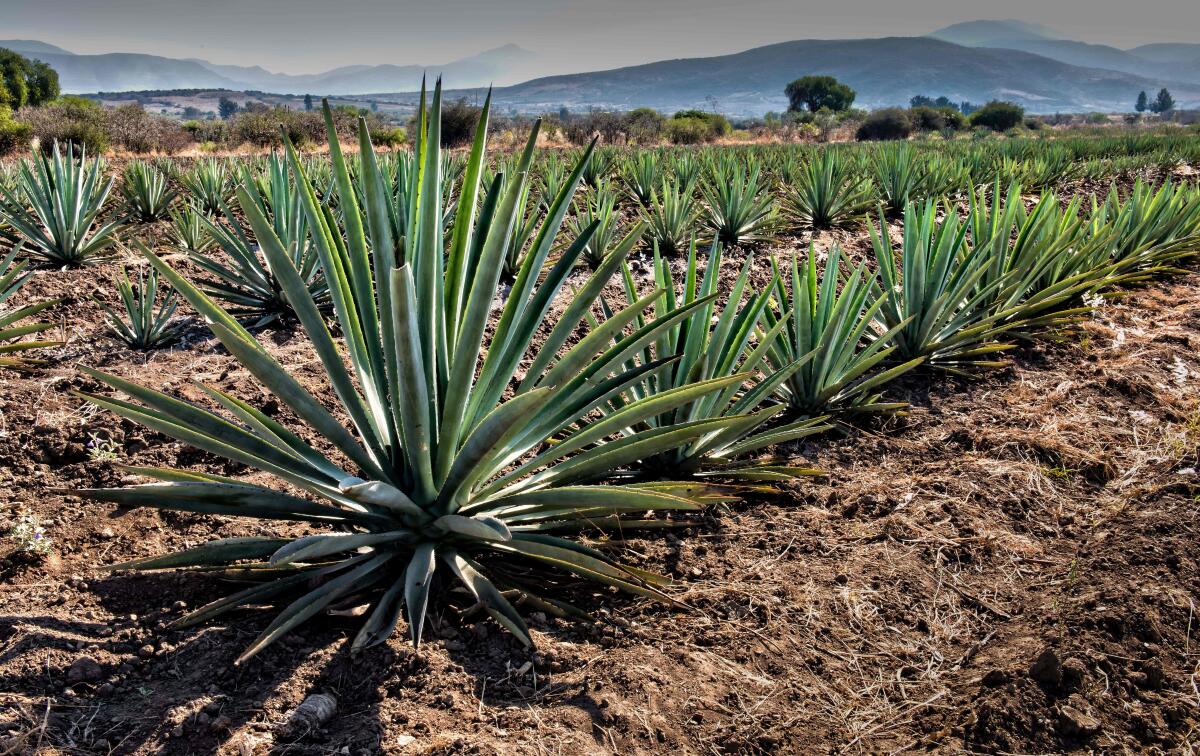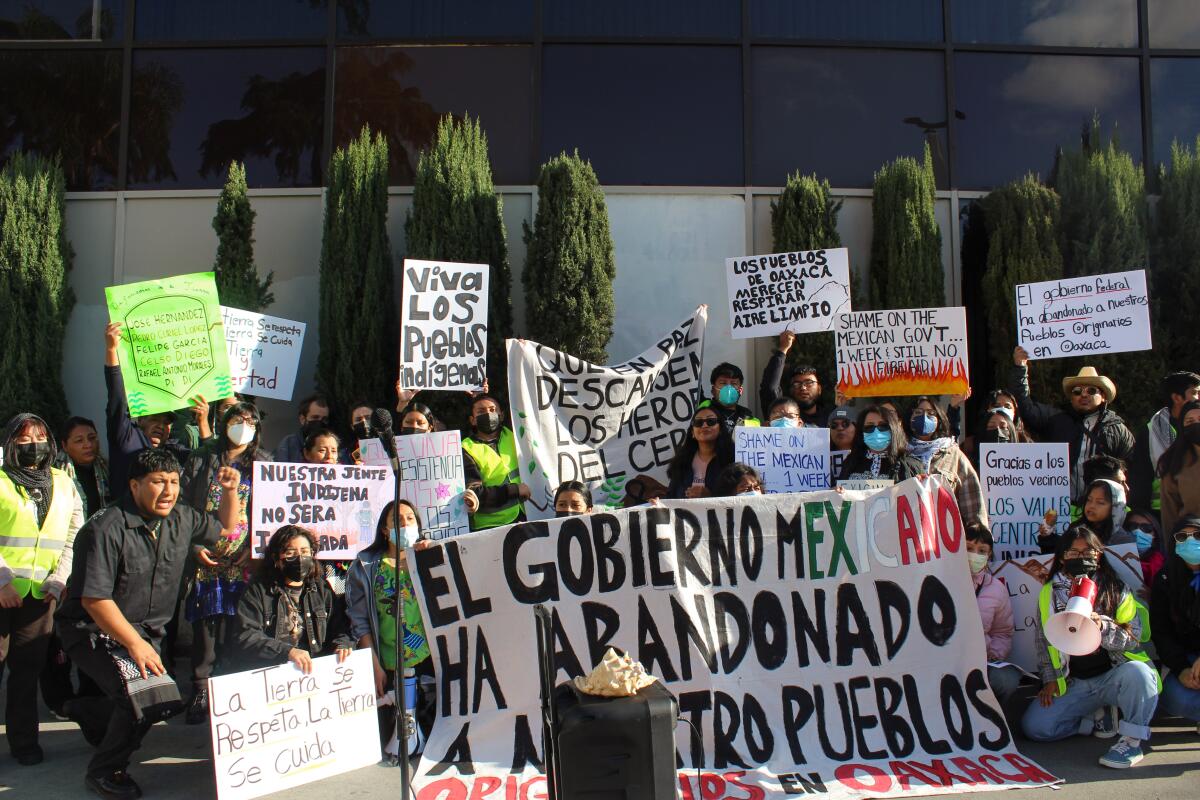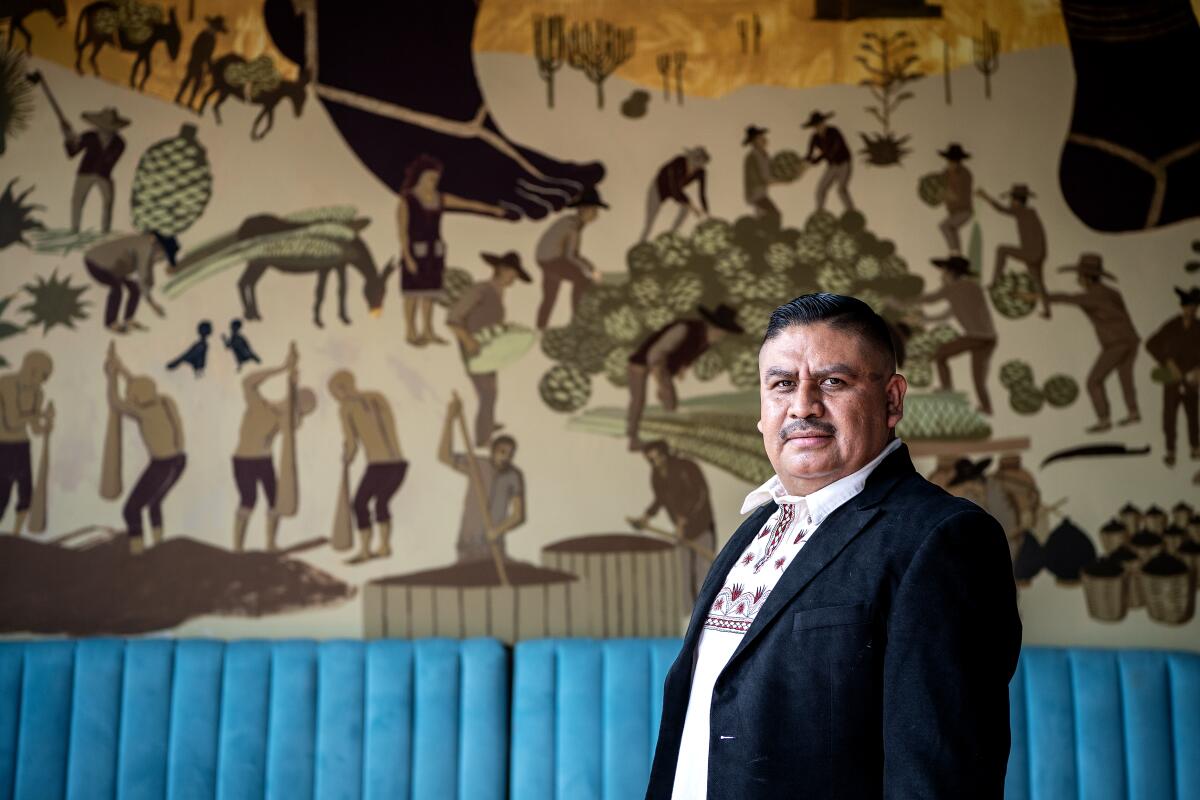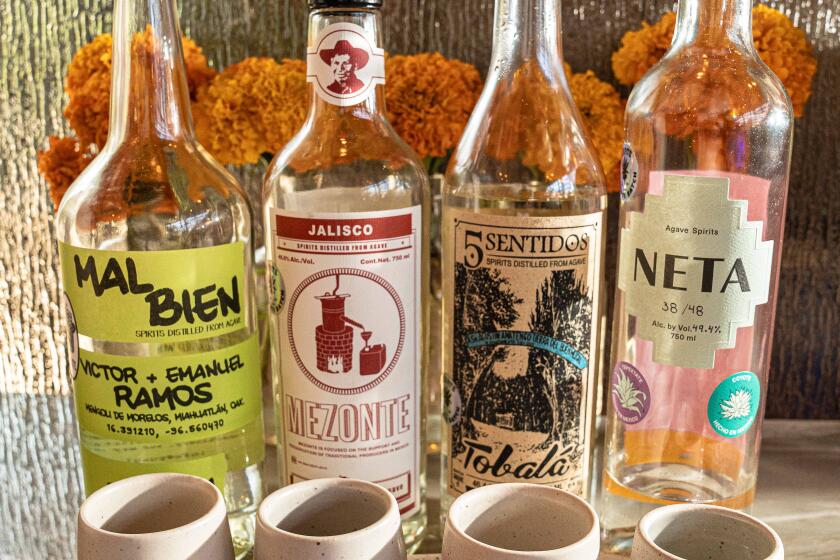L.A.’s Oaxacan community rallies after wildfire devastates a region of Mexico famed for its mezcal

- Share via
The photos and videos began flooding in Feb. 27. In a region of Oaxaca famous for its flavorful mezcal, a wildfire was raging dangerously close to the town of San Lucas Quiaviní.
Massive plumes of smoke choked the horizon as the flames drove toward the town of 1,700. At nightfall, local officials put out an urgent call for volunteers to head out the next morning to beat back the fire. They asked for people over 18 who knew the roads and urged them to don helmets and face masks.
It would be days before the state government intervened with enough equipment and resources to get the blaze under control. In the interim, residents of San Lucas Quiaviní and neighboring towns in this agave-growing hub tried to mount a defense with shovels, pick axes and what little water they could spare.
By the time the government declared the wildfire contained on March 5, it had scorched more than 1,700 acres. And five men from San Lucas Quiaviní had died after heeding the call to battle.
Some of the fire victims had worked in Los Angeles and have close family here. Their deaths have struck an emotional chord in the city, home to the largest Indigenous Oaxacan population outside Mexico. Oaxacan restaurant owners and youth organizers have rallied in support, raising money and donations to help the families and towns that suffered losses.
The men killed have been identified by local officials and organizers as Rafael Antonio Morales, 65; Pedro Curiel Diego, 64; Felipe Garcia, 41; Celso Diego, 65; and Jose Hernandez Lopez, 47. All were farmers.
The relatives and restaurateurs organizing support in Los Angeles say the Mexican government failed the towns, waiting too long to mount an aerial defense. More broadly, they believe that the boom in mezcal production in this region of Oaxaca has left Indigenous communities more vulnerable to natural disaster.
Mezcal, long a traditional and medicinal drink for Oaxacans, has swelled in popularity in the U.S. and beyond as a younger generation turns to craft spirits. As demand for the smoky liquor has climbed, vast tracts of forest in Oaxaca have been torn up and planted with agave, eroding the soil and weakening natural defenses in a mountainous region prone to wildfire and mudslides.

At least 50 wildfires have broken out in Oaxaca in just the first few months of 2024 — though the state’s wildfire season typically starts in mid-March, according to El Universal, a Mexican publication.
“We’re in a critical period of drought and heat,” Oaxaca Gov. Salomon Jara Cruz said at a March 5 news conference. “The consequences are that we are more prone to any wildfire, whether it be brief, slight.”
Jara Cruz acknowledged the state was delayed in getting air support to San Lucas Quiaviní, but he said it readily deployed 267 personnel and 50 vehicles on the ground. He showed videos of the massive fire taken from the air, as well as images of San Lucas Quiaviní women carrying plastic jugs of water on their heads as they trekked up steep hills to deliver water to the men fighting the fire. The men who died had reportedly gone missing on Feb. 28, the day after they volunteered for duty.
“At all times, we have acted with responsibility and timeliness to protect the lives and integrity of Oaxacans,” Jara Cruz said.
In Los Angeles, days after the bodies were discovered, Indigenous youth held a rally in front of the Mexican consulate office in MacArthur Park to protest what they said was the government’s lax efforts to protect the people of San Lucas Quiaviní.
“I’ve heard from my cousin that they don’t even have proper shoes. They only have huaraches,” said Brenda Diego, who is Zapotec and lost an uncle in the fire. “They’re using machetes; they’re using shovels. They didn’t have anything prepared for a fire.”

Mireya Curiel, one of the Zapotec youth organizers, said she was related to three of the men who died. Rafael Antonio Morales, her grandfather’s cousin, was known to offer a friendly smile and helping hand around town. Two others, Pedro Curiel Diego and Celso Diego, were her uncles.
“Not only were these folks older, but these folks were also experts in the land,” said organizer Randy Santiago, a Zapotec of Santiago Matatlán. “Their loss to their community has been immeasurable. Their expertise, their knowledge of the land, their knowledge of tradition, culture, everything, has now been lost. That is the fault of the government.”
In recent days, the youth group has collected supplies requested by people in Oaxaca: masks and respirators, fire-resistant boots and clothing, battery-powered headlamps, compression gloves and socks. They were able to ferry the supplies to Tijuana, where someone picked them up and delivered them to Oaxaca in southern Mexico. They have raised more than $40,000 to purchase more supplies and support families affected by the fire.
Jose Curiel of Venice lost an uncle, Pedro Curiel Diego. He has launched a GoFundMe campaign to raise money for his cousin, Diego’s daughter. His uncle spent about 10 years working as a dishwasher in Los Angeles before returning to the hometown he dearly missed, Curiel said.
San Lucas Quiaviní, Curiel said, is a rustic town where few people have cars and some households still collect water with barrels. It doesn’t have the draw of bigger towns in the region — such as Santiago Matatlán, known as the “world capital of mezcal” — that offer tourist packages combining mezcal-tasting with tours of the agave fields. But it is peaceful, and many in L.A.’s Oaxacan community plan to return there to build their dream homes. He said the men who died did so in defense of that sense of community.
“They went out to help, to make sure not only that they were safe, but to save their families, their town, their whole community,” Curiel said.

Ivan Vasquez, the owner of Madre Oaxacan Restaurant & Mezcaleria, which has four locations in Los Angeles County, spent a recent Sunday evening auctioning off vintage bottles of mezcal to raise funds for the towns affected, an event that generated more than $8,000. Vasquez, a native of Oaxaca City, travels to the region frequently to buy spirits from small-batch mezcaleros.
Vasquez said he was frustrated by the lack of awareness among large mezcal production companies moving into Oaxaca that benefit from the sprawling agave fields but have yet to support the communities affected by fire.
Take a trip to Oaxaca or Jalisco at one of L.A.’s best agave-focused bars, including tequila and mezcal flights from small-batch producers, craft cocktails and more.
“Every single time that I go to Oaxaca and I go out of the city and go to the pueblos, you see more fields of agave replacing the trees,” he said. “The more agave you see, the more flattened land, the more fires we’re going to get. And the less water we’re going to get.”
Vasquez, who is Zapotec, said he worries about the future of the Indigenous communities as the mezcal market continues to reshape rural Oaxaca and global warming exacerbates conditions.
“This is just the beginning,” he said.
More to Read
Sign up for Essential California
The most important California stories and recommendations in your inbox every morning.
You may occasionally receive promotional content from the Los Angeles Times.












